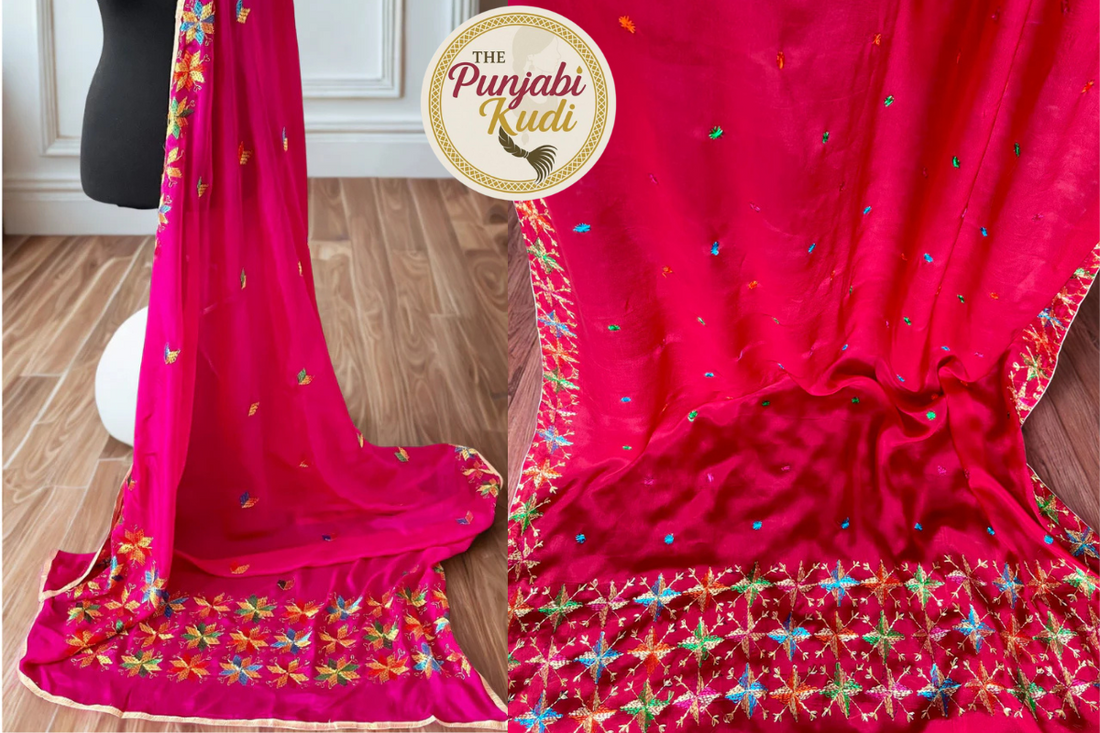
What is Phulkari? Exploring the Beauty of Punjabi Embroidery
Share
The word Phulkari translates to “flower work”, but if you ask anyone who has grown up with it, they’ll tell you it means much more than that. It’s the dupatta your dadi or nani may have pulled out on a wedding day. It’s the fabric that carries stories of laughter, patience, and love stitched late into the night.
Traditionally, women in Punjab would create Phulkari not just as clothing, but as a keepsake – a way of wrapping their emotions into thread. A daughter’s trousseau often carried Phulkari made by her mother or grandmother. Every stitch was a blessing, every color chosen with joy. That’s why even today, when we drape Phulkari, it feels like carrying a piece of home on our shoulders.

The Fabric
Traditionally, it was stitched on khaddar, a hand-spun, handwoven cotton fabric that was strong enough to hold the dense embroidery yet soft to wear. Khaddar’s earthy texture made it the perfect canvas for the bright silk threads that brought Phulkari motifs to life.
Over time, as styles evolved, artisans began using lighter fabrics like georgette, chiffon, and silk to make Phulkari more versatile and wearable for modern occasions.

The Making of Phulkari
Phulkari embroidery is traditionally crafted using vibrant silk threads and a darning stitch worked from the reverse side of khaddar, a coarse cotton fabric. This distinctive technique defines the character of Phulkari needlework. Originally, Phulkari embellishments adorned only shawls and odhanis, but today, sarees and churidar kameez have become popular surfaces for these elaborate designs. The darning stitch remains the signature element and is central to the intricate patterns for which Phulkari is celebrated.
Types of Phulkari embroidery
- Bagh Phulkari: Dense embroidery covering the entire fabric, leaving no base visible. Worn at weddings and grand celebrations.
- Chope: Gifted by mothers or grandmothers to brides. Red or maroon with golden borders, symbolizing blessings.
- Suber: A bridal dupatta with auspicious motifs like mirrors or coins, representing prosperity and happiness.
- Tilpatra: Light embroidery with small scattered motifs, simple and elegant for everyday wear.
- Darshan Dwar: Offered in temples or gurdwaras, with designs resembling gateways of faith and devotion.
- Sainchi: Storytelling Phulkari with motifs of village life – animals, farmers, and daily scenes.
- Bawan Bagh (52 Garden): Features 52 different patterns on a single piece and is considered very rare and showcases the versatility of the artisan.
- Kaudi Bagh: Motifs of cowrie shells, made for brides as a symbol of fertility and prosperity.
- Panchranga & Satranga: Phulkaris with five (panch) or seven (satrang) colors, vibrant and joyful like festivals.
The Punjabi Kudi Phulkari Dupattas
Here at The Punjabi Kudi, our Phulkari dupattas are created with that same spirit – a balance of tradition and style. Some are bright and festive, perfect for celebrations, while others have a subtle charm that can instantly elevate a simple suit. We want our dupattas to feel like heirlooms, something you’ll love wearing today and treasure for years to come.
